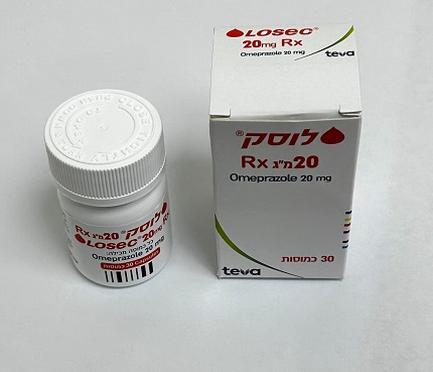Quest for the right Drug

לוסק 20 מ"ג RX LOSEC 20 MG RX (OMEPRAZOLE)
תרופה במרשם
תרופה בסל
נרקוטיקה
ציטוטוקסיקה
צורת מתן:
פומי : PER OS
צורת מינון:
קפסולות : CAPSULES
עלון לרופא
מינוניםPosology התוויות
Indications תופעות לוואי
Adverse reactions התוויות נגד
Contraindications אינטראקציות
Interactions מינון יתר
Overdose הריון/הנקה
Pregnancy & Lactation אוכלוסיות מיוחדות
Special populations תכונות פרמקולוגיות
Pharmacological properties מידע רוקחי
Pharmaceutical particulars אזהרת שימוש
Special Warning עלון לרופא
Physicians Leaflet
Special Warning : אזהרת שימוש
4.4 Special warnings and precautions for use In the presence of any alarm symptom (e.g. significant unintentional weight loss, recurrent vomiting, dysphagia, haematemesis or melena) and when gastric ulcer is suspected or present, malignancy should be excluded, as treatment may alleviate symptoms and delay diagnosis. Co-administration of atazanavir with proton pump inhibitors is not recommended (see section 4.5). If the combination of atazanavir with a proton pump inhibitor is judged unavoidable, close clinical monitoring (e.g virus load) is recommended in combination with an increase in the dose of atazanavir to 400 mg with 100 mg of ritonavir; omeprazole 20 mg should not be exceeded. Omeprazole, as all acid-blocking medicines, may reduce the absorption of vitamin B12 (cyanocobalamin) due to hypo- or achlorhydria. This should be considered in patients with reduced body stores or risk factors for reduced vitamin B12 absorption on long-term therapy. Omeprazole is a CYP2C19 inhibitor. When starting or ending treatment with omeprazole, the potential for interactions with drugs metabolised through CYP2C19 should be considered. An interaction is observed between clopidogrel and omeprazole (see section 4.5). The clinical relevance of this interaction is uncertain. As a precaution, concomitant use of omeprazole and clopidogrel should be discouraged. Severe hypomagnesaemia has been reported in patients treated with proton pump inhibitors (PPIs) like omeprazole for at least three months, and in most cases for a year. Serious manifestations of hypomagnesaemia such as fatigue, tetany, delirium, convulsions, dizziness and ventricular arrhythmia can occur but they may begin insidiously and be overlooked. In most affected patients, hypomagnesaemia improved after magnesium replacement and discontinuation of the PPI. For patients expected to be on prolonged treatment or who take PPIs with digoxin or drugs that may cause hypomagnesaemia (e.g. diuretics), healthcare professionals should consider measuring magnesium levels before starting PPI treatment and periodically during treatment . Severe cutaneous adverse reactions (SCARs) including Stevens-Johnson syndrome (SJS), toxic epidermal necrolysis (TEN), drug reaction with eosinophilia and systemic symptoms (DRESS) and acute generalized exanthematous pustulosis (AGEP), which can be life-threatening or fatal, have been reported very rarely and rarely, respectively in association with omeprazole treatment. Proton pump inhibitors, especially if used in high doses and over long durations (>1 year), may modestly increase the risk of hip, wrist and spine fracture, predominantly in the elderly or in presence of other recognised risk factors. Observational studies suggest that proton pump inhibitors may increase the overall risk of fracture by 10-40%. Some of this increase may be due to other risk factors. Patients at risk of osteoporosis should receive care according to current clinical guidelines and they should have an adequate intake of vitamin D and calcium. Subacute cutaneous lupus erythematosus (SCLE) Proton pump inhibitors are associated with very infrequent cases of SCLE. If lesions occur, especially in sun-exposed areas of the skin, and if accompanied by arthralgia, the patient should seek medical help promptly and the health care professional should consider stopping Losec. SCLE after previous treatment with a proton pump inhibitor may increase the risk of SCLE with other proton pump inhibitors. Renal impairment Acute tubulointerstitial nephritis (TIN) has been observed in patients taking omeprazole and may occur at any point during omeprazole therapy (see section 4.8). Acute tubulointerstitial nephritis can progress to renal failure. Omeprazole should be discontinued in case of suspected TIN, and appropriate treatment should be promptly initiated. Interference with laboratory tests Increased Chromogranin A (CgA) level may interfere with investigations for neuroendocrine tumours. To avoid this interference, omeprazole treatment should be stopped for at least 5 days before CgA measurements (see section 5.1). If CgA and gastrin levels have not returned to reference range after initial measurement, measurements should be repeated 14 days after cessation of proton pump inhibitor treatment. Some children with chronic illnesses may require long-term treatment although it is not recommended. Losec contains lactose. Patients with rare hereditary problems of galactose intolerance, the total lactase deficiency or glucose-galactose malabsorption should not take this medicine. Losec contains less than 1 mmol sodium (23 mg) per capsule, that is to say essentially ‘sodium- free’. Treatment with proton pump inhibitors may lead to slightly increased risk of gastrointestinal infections such as Salmonella and Campylobacter and, in hospitalised patients, possibly also Clostridium difficile (see section 5.1). As in all long-term treatments, especially when exceeding a treatment period of 1 year, patients should be kept under regular surveillance.
Effects on Driving
4.7 Effects on ability to drive and use machines Losec has no or negligible influence on the ability to drive or use machines. However, adverse drug reactions such as dizziness and visual disturbances may occur (see section 4.8). If affected, patients should not drive or operate machinery.

פרטי מסגרת הכללה בסל
הטיפול בתרופה יינתן להתוויות האלה: 1. טיפול בכיב בתריסריון ובכיב קיבה. 2. טיפול לטווח ארוך וטיפול אחזקה (maintenance therapy) בדלקות של הושט. 3. טיפול אחזקה למניעת הישנות המחלה בחולים הלוקים בכיב פפטי שאינו מגיב לטיפול. 4. הכחדה של החיידק Helicobacter pylori המלווה כי פפטי ובשילוב עם אנטיביוטיקה. 5. טיפול בתסמונת זולינגר-אליסון 6. טיפול ומניעה של כיבים בתריסריון, כיבים קיבתיים או שחיקות קיבתיות בחולים בסיכון גבוה, הנובעים מטיפול בתרופות אנטי דלקתיות שאינן סטרואידים (משפחת NSAID).
מסגרת הכללה בסל
התוויות הכלולות במסגרת הסל
| התוויה | תאריך הכללה | תחום קליני | Class Effect | מצב מחלה |
|---|---|---|---|---|
| טיפול ומניעה של כיבים בתריסריון, כיבים קיבתיים או שחיקות קיבתיות בחולים בסיכון גבוה, הנובעים מטיפול בתרופות אנטי דלקתיות שאינן סטרואידים (משפחת NSAID). | ||||
| טיפול בתסמונת זולינגר-אליסון | ||||
| הכחדה של החיידק Helicobacter pylori המלווה כיב פפטי ובשילוב עם אנטיביוטיקה. | ||||
| טיפול אחזקה למניעת הישנות המחלה בחולים הלוקים בכיב פפטי שאינו מגיב לטיפול | ||||
| טיפול לטווח ארוך וטיפול אחזקה (maintenance therapy) בדלקת של הושט | ||||
| טיפול בכיב בתריסריון ובכיב קיבה |
שימוש לפי פנקס קופ''ח כללית 1994
Severe reflux esophagitis refractory to other treatments - duration of therapy up to 3 months only. Zollinger-Eliison syndrome. יירשם ע"י רופא גסטרואנטרולוג
תאריך הכללה מקורי בסל
01/01/1995
הגבלות
תרופה מוגבלת לרישום ע'י רופא מומחה או הגבלה אחרת
מידע נוסף
עלון מידע לצרכן
28.03.17 - עלון לצרכן אנגלית 21.08.22 - עלון לצרכן עברית 28.03.17 - עלון לצרכן ערבית 19.10.22 - עלון לצרכן אנגלית 06.09.22 - עלון לצרכן עברית 19.10.22 - עלון לצרכן ערבית 16.08.23 - עלון לצרכן עברית 12.10.23 - עלון לצרכן אנגלית 12.10.23 - עלון לצרכן ערבית 05.07.12 - החמרה לעלון 05.07.12 - החמרה לעלון 05.07.12 - החמרה לעלון 22.12.13 - החמרה לעלון 29.05.14 - החמרה לעלון 05.07.16 - החמרה לעלון 12.05.22 - החמרה לעלון 01.06.22 - החמרה לעלון 16.08.22 - החמרה לעלון 21.08.22 - החמרה לעלון 06.09.22 - החמרה לעלון 17.08.23 - החמרה לעלון 07.12.23 - החמרה לעלון 30.09.24 - החמרה לעלוןלתרופה במאגר משרד הבריאות
לוסק 20 מ"ג RX